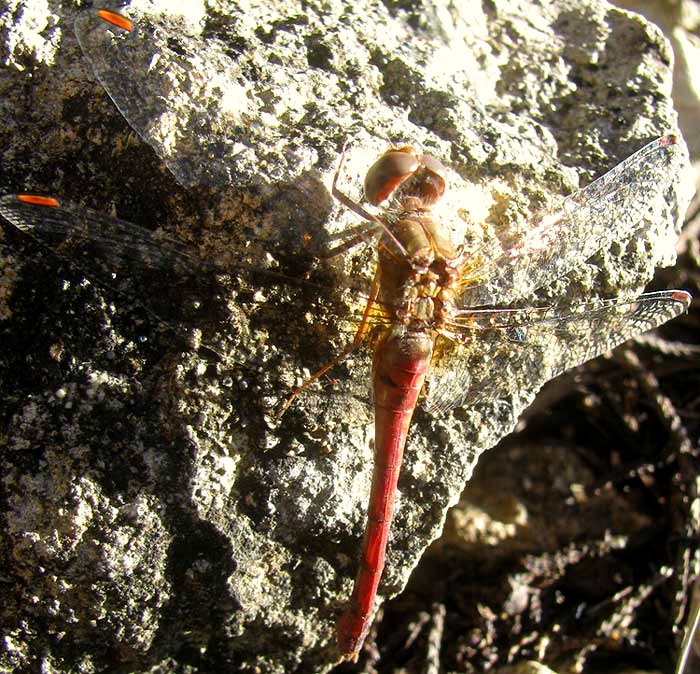Excerpts from Jim Conrad's
Naturalist Newsletter

from the December 29, 2013 Newsletter issued from the Frio Canyon Nature Education Center in the valley of the Dry Frio River in northern Uvalde County, southwestern Texas, on the southern border of the Edwards Plateau; elevation ~1750m (~5750 ft); N29.62°, W99.86°; USA
YELLOW-LEGGED MEADOWHAWK
On flat, unvegetated, Edwards Limestone bedrock capping the very top of our hill, on Solstice Day I was surprised when a red dragonfly landed right beside me. The surprise was not only because it was so late in the year and after several hard freezes, but also because we were about half a mile (0.8km) from the Dry Frio's nearest standing water. That's the critter above.
Earlier this month we profiled the Variegated Meadowhawk Dragonfly, similarly red, and described in Dunkle's Dragonflies through Binoculars as "... the dragonfly most likely to be seen in the desert miles from water." Surely this was the same species. The Variegated Meadowhawk is shown at http://www.backyardnature.net/n/a/meadhawk.htm.
However, there you can see that that species displays a distinct "red-skeleton" ornamentation on its slender rear end, which our hilltop one lacks, plus the bases of the four wings of that one aren't flushed with amber like this one's. This must be a new species!
The hilltop species looked enough like the previous meadowhawk for me to go directly to the dragonfly book's meadowhawk page, where the new species was pictured just below the previous one. It's the Yellow-legged Meadowhawk, SYMPETRUM VICINUM, in the same genus as the Variegated species. And once the Yellow-legged name brought my attention to the matter, in fact the Yellow-legged does have yellow legs, which look even more brightly yellow than they are when viewed from above through the dragonfly's amber wing bases. The Variegated Meadowhawk's legs are black with yellow stripes.
Once again Dunkle's description of the species' hits the spot exactly, when he writes that "... it may not begin breeding until late Aug., and is often the last dragonfly seen each year."
More and more it's becoming clear that the various dragonfly species are much more distinctive than I ever thought possible, and each species seems to have its own personality. For example, Dunkle says of the Yellow-legged Meadowhawk that "At low temperatures they perch on the ground, switching to leaves, and then to stems as the temperature increases. Pairs often form tandems away from water, then fly to water where they make false egg-laying movements before mating and commencing real egg laying."
Yellow-legged Meadowhawks are widely and curiously distributed in North America, from southeastern Canada to northern Florida west to New Mexico and North Dakota, with a thin isthmus of population extending westward, where they spread from northern California to southern British Columbia.